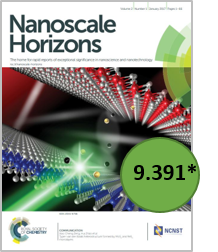New in 2019, we are delighted to announce a series of post-publication online article collections, led by our Community Board members across both Materials Horizons and Nanoscale Horizons.
The Community Boards that support both Horizons journals aim to provide a platform for early career researchers to share their experiences and ideas on scientific publishing. Working together and sharing their unique expertise, our Community Board members have recommended several key topics where significant, rapid progress has been made in the last 2 years. They have selected top articles published in the Horizons journals to showcase the most important advances in each topic area.
Nanobiomedicine
To kick things off, Chandra Kumar Dixit and Christopher M. Proctor present the first Horizons Community Board Collection:
Horizons Community Board Collection – Nanobiomedicine
“Advancements in nanotechnology are impacting biology and medicine. In this themed collection, we are compiling some noteworthy articles in the areas related to targeted delivery, vaccines, diagnostics, wound healing, and self-healing scaffolds & materials. Theranostics, which is a new branch specifically dealing with point-of-care, involves diagnostics and therapy in a single agent. Carbon-based materials are proving to be effective agents in this quest, as indicated by Kapil Patel et al. in their research published in Materials Horizons (DOI: 10.1039/C8MH00966J). Anand et al. (DOI: 10.1039/C8NH00174J) emphasized in their review article the potential of carbon-based nanomaterials as antimicrobial agents. Scaffolds and matrices based on nanomaterials, as illustrated through the research works of Yu et al. (DOI: 10.1039/C8MH00647D), Singh et al. (DOI: 10.1039/C8MH01298A), Ooi (DOI: 10.1039/C7MH00373K), and Liu (DOI: 10.1039/C8MH00704G) have shown tremendous potential in surgery, wound healing, controlled release skin patches, etc. Given how all of these materials show potential in their respective fields, it will be important to see how these will shape the future of biomedicine. We hope that the readers find this themed collection informative and useful.”
Chandra Kumar Dixit and Christopher M. Proctor
Guest Editors

Chandra Kumar Dixit
Nanoscale Horizons Community Board Member, Chandra Kumar Dixit is a Scientist at Qiagen Sciences working in the areas of IVD and nanodiagnostics. He received a BSc degree in Biology from Bundelkhand University, an MSc degree in Biotechnology from CCS University and was awarded a PhD in Biotechnology from Dublin City University in 2012. His postdoctoral training spanned from Dublin City University, Ireland, Technion IIT, Israel, and University of Connecticut, USA, in areas of microfluidic tools, glycobiology, cell biology, disease diagnosis, electrochemistry, prostate cancer, 3D-printed tools for fluidic devices, and novel nanomaterials. He has published over 40 international research papers including reviews, books, and book chapters in the areas of biosensors, conventional and 3D-printed microfluidics, and disease diagnostics, and has won several international fellowships including the Marie-Curie grant.

Christopher M. Proctor
Materials Horizons Community Board member Christopher M. Proctor received a BSc in Interdisciplinary Physics from the University of Michigan in 2008. Following two years as a general scientist at the U.S. Nuclear Regulatory Commission, he earned a PhD in Materials from the University of California, Santa Barbara, where he investigated loss mechanisms in organic photovoltaics (2015). Subsequently, Chris was awarded a postdoctoral fellowship from Whitaker International to develop implantable bioelectronic devices for treating neurological disorders at the Ecole des Mines de St Etienne. He is now a Research Associate and Borysiewicz Biomedical Sciences Fellow at the University of Cambridge where his research is focused on engineering devices and developing materials to enable a seamless connection between electronics and living tissue for applications including epilepsy, cancer and pain management.
We hope you enjoy reading this collection.
Comments Off on Horizons Community Board Collection – Nanobiomedicine



























